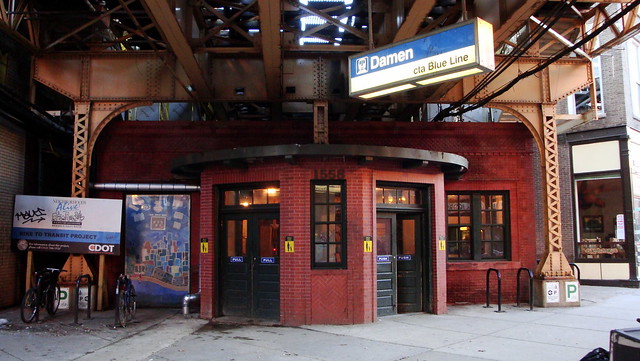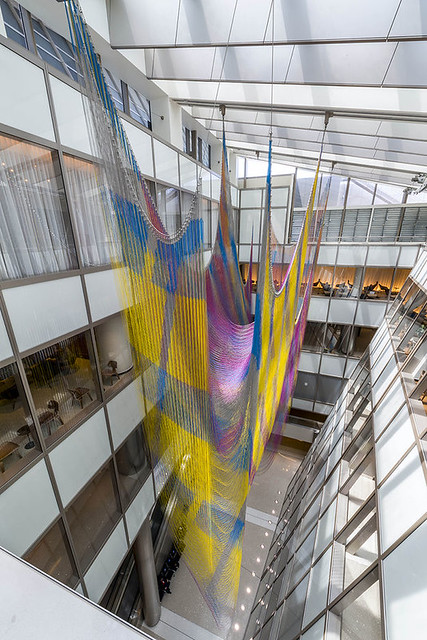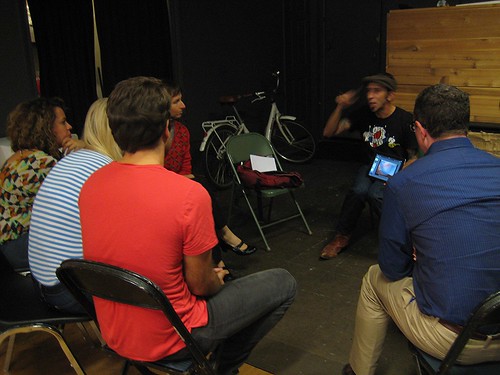On Wednesday, the Chicago Transit Authority hosted a public meeting to introduce Wicker Park residents to artist Gaston Noques, whose team will create a new work for the Damen Blue Line station, adjacent to the busy Wicker Park intersection of Milwaukee, North, and Damen. The ‘L’ stop will receive substantial improvements as part of the Your New Blue project, which will also rehab the neighboring California and Western stations on the O’Hare Line. Noques’ artwork will remain at the Damen stop for at least five years.
The Damen station will be closed from October 20th to December 22nd, with CTA trains running express between Division and Western. While the station is closed, construction crews will repair and repaint the Damen station house, as well as install new platforms with improved lighting, new signage, and new bike racks. The CTA will temporarily increase service on the #56 Milwaukee bus line to serve Wicker Park and Bucktown customers while the station is closed.
The Damen stop is registered as a local and national historic landmark. Built at the turn of the century, it currently handles about 12 million riders a year. The remodel aims to preserve the station's historic integrity while making the station safer, more comfortable, and more pleasant to use. "[The station is] really cinematic," Wicker Park resident Ashley Galloway commented during the meeting. "Every time I'm at La Colombe [a neighboring coffee house], I feel like I'm in a movie. It's the heart of this neighborhood."
The CTA selected a proposal by Nogues' Los Angeles-based art studio Ball-Nogues from 100 submissions received during a public call for artists. "Our environment is very important,” Nogues told the attendees at the meeting, held at the Silver Room jewelry boutique. He showed photos of his design and fabrication studio, which is full of heavy machinery and large artworks in various states of assembly. “When you're doing something, when you're fabricating something, you have that connection to that artwork being made... Unlike a lot of people, we make what we design.”
Nogues compared his studio’s design and fabrication techniques to those of automobile magnate Henry Ford. “To create the Model T, he had to invent the production line," the artisit said. "He had to invent the production line to create what we have outside right now -- [car] traffic."
Ball-Nogues' version of the production line uses custom-built assembly machinery, as well as proprietary computer software that allows them to visualize many different potential versions of a project much faster than traditional modeling, Nogues said. Their creative process is rooted in playing with materials in innovative ways: inflating metal, burning items with a lens, or creating massive papier mâché works with concrete.
His previous projects include elaborate constructions of string or chain that give dimension and shape to empty space. Nogues showed the group photos of installations that look like a child's vividly colored Spirograph drawing, only suspended in midair. Viewed from different angles, natural light hits the object in various ways and the colors blend and shift.
“The material begins to become immaterial," Noques said. "It begins to look like floating light, it begins to look like rain streaks, it begins to look like anything but stainless steel chain,” he explained while showing images of “Air Garden,” an installation in the Bradley West Terminal at the Los Angeles International Airport.
Other Ball-Nogues installations in public spaces use mirror-polished stainless steel balls piled into domes that reflect the landscape around them, or translucent colored plastic that casts brightly colored shadows as sunlight passes through it. Nogues promised meeting attendees that he would to study the unique character of the historic Damen stop, and incorporate it into his design.
The artwork may not be ready for installation for another year, long after the other station upgrades are completed. As the Blue Line rumbled faintly in back of the jewelry shop, CTA project coordinator Elizabeth Kelley and government and community relations officer Jeff Wilson took input and answered questions from residents.
One issue raised was that the $8.1 million renovation won't make the station compliant with the Americans With Disabilities Act. The CTA won't be adding an elevator, which means people in wheelchairs still will not be able to access the platform, and the stairs will still present a barrier to others with mobility issues. "This is a really exciting project,” Chicago resident and artist Janice Bond commented. “I just find it unfortunate that people with disabilities won't be able to experience it."
The CTA staffers responded that electrical upgrades that will take place during the rehab, which will allow for the installation of an elevator once more funding becomes available. In the meantime, riders with disabilities can use the ADA-complaint 56-Milwaukee bus or Western Blue Line stop.






